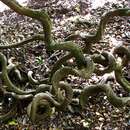en
names in breadcrumbs


Entada phaseoloides[2][3][4][5][6] commonly named the box bean or St. Thomas’ bean, first described by Linnaeus, with its current name described by Merrill. E. phaseoloides is a liana in the pea family:[7][8] called gugo, balugo or tamayan in the Philippines and bàm bàm in Viet Nam. No subspecies are listed in the Catalogue of Life.[7]
Entada phaseoloides is a large liana that climbs high into the lowland tropical forest canopy and found in lowland coastal forests of Africa, Australia, Asia and the Western Pacific. The lianas are often (but not exclusively) associated with waterways and seeds are widely dispersed by oceanic currents. Two subspecies have been described:[9]
The leaf structure is bi-pinnate compound divided into one to two pairs of leaflets. Leaflets are somewhat elliptical, between 25 and 100 mm (0.98 and 3.94 in) long and 10 to 60 mm (0.39 to 2.36 in) wide. Flowers are arranged in a raceme with green to red coloured sepals and green / cream petals that are between 2–3.5 mm (0.079–0.138 in) long. The characteristic pods can grow very large, up to 2 m (6 ft 7 in) long and 130 mm (5.1 in) wide. Each pod contains between 10 and 20 reddish brown seeds that are lens-shaped and about 40 to 60 mm (1.6 to 2.4 in) in diameter.
Filipinos have been traditionally using gugo before commercial shampoos were sold in stores. The shampoo is obtained by soaking and rubbing the bark of the vine gugo (Entada phaseoloides), [10][11] producing a lather that cleanses the scalp effectively. Gugo is also used as an ingredient in hair tonics.[12] A study by the Department of Science and Technology found that gugo prevents hairfall because it stimulates micro circulation in the blood vessels.[13]
The people of Tonga use the beans of this plant (known as paʻanga) as ankle decorations for their traditional kailao dance as well as for use in an ancient game called lafo.[14][15] The paʻanga is also the name given to their currency.[15]
Entada phaseoloides commonly named the box bean or St. Thomas’ bean, first described by Linnaeus, with its current name described by Merrill. E. phaseoloides is a liana in the pea family: called gugo, balugo or tamayan in the Philippines and bàm bàm in Viet Nam. No subspecies are listed in the Catalogue of Life.